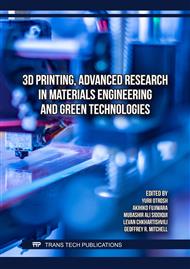[1]
Shaker MM, Taha HS, Kandil HI, Kamal HM, Mahrous HA, Elamragy AA. Prognostic significance of right ventricular dysfunction in patients presenting with acute left-sided heart failure. The Egyptian Heart Journal 2024;76:2.
DOI: 10.1186/s43044-023-00432-8
Google Scholar
[2]
Malakar AK, Choudhury D, Halder B, Paul P, Uddin A, Chakraborty S. A review on coronary artery disease, its risk factors, and therapeutics. J Cell Physiol 2019;234:16812–23.
DOI: 10.1002/jcp.28350
Google Scholar
[3]
Ullah M, Wahab A, Khan SU, Zaman U, Rehman K ur, Hamayun S, et al. Stent as a Novel Technology for Coronary Artery Disease and Their Clinical Manifestation. Curr Probl Cardiol 2023;48:101415.
DOI: 10.1016/j.cpcardiol.2022.101415
Google Scholar
[4]
Capodanno D, Bhatt DL, Gibson CM, James S, Kimura T, Mehran R, et al. Bleeding avoidance strategies in percutaneous coronary intervention. Nat Rev Cardiol 2022;19:117–32.
DOI: 10.1038/s41569-021-00598-1
Google Scholar
[5]
Doenst T, Thiele H, Haasenritter J, Wahlers T, Massberg S, Haverich A. The treatment of coronary artery disease—current status six decades after the first bypass operation. Dtsch Arztebl Int 2022.
DOI: 10.3238/arztebl.m2022.0277
Google Scholar
[6]
Ho MY, Chen CC, Wang CY, Chang SH, Hsieh MJ, Lee CH, et al. The development of coronary artery stents: From bare-metal to bio-resorbable types. Metals (Basel) 2016;6.
DOI: 10.3390/met6070168
Google Scholar
[7]
Schmidt T, Abbott JD. Coronary stents: History, design, and construction. J Clin Med 2018;7.
DOI: 10.3390/jcm7060126
Google Scholar
[8]
Beshchasna N, Saqib M, Kraskiewicz H, Wasyluk Ł, Kuzmin O, Duta OC, et al. Recent advances in manufacturing innovative stents. Pharmaceutics 2020;12.
DOI: 10.3390/pharmaceutics12040349
Google Scholar
[9]
Polanec B, Kramberger J, Glodež S. A review of production technologies and materials for manufacturing of cardiovascular stents. Advances in Production Engineering And Management 2020;15:390–402.
DOI: 10.14743/APEM2020.4.373
Google Scholar
[10]
Popović M, Pjević M, Milovanović A, Mladenović G, Milošević M. Printing parameter optimization of PLA material concerning geometrical accuracy and tensile properties relative to FDM process productivity. Journal of Mechanical Science and Technology 2023;37:697–706.
DOI: 10.1007/s12206-023-0113-6
Google Scholar
[11]
Frunzaverde D, Cojocaru V, Bacescu N, Ciubotariu CR, Miclosina CO, Turiac RR, et al. The Influence of the Layer Height and the Filament Color on the Dimensional Accuracy and the Tensile Strength of FDM-Printed PLA Specimens. Polymers (Basel) 2023;15.
DOI: 10.3390/polym15102377
Google Scholar
[12]
Yang Y, Dai X, Yang B, Zou P, Gao F, Duan J, et al. Optimization of polylactic acid 3D printing parameters based on support vector regression and cuckoo search. Polym Eng Sci 2023;63:3243–53.
DOI: 10.1002/pen.26440
Google Scholar
[13]
Baraheni M, Shabgard MR, Tabatabaee AM. Effects of FDM 3D printing parameters on PLA biomaterial components dimensional accuracy and surface quality. Proc Inst Mech Eng C J Mech Eng Sci 2024;238:3864–73.
DOI: 10.1177/09544062231202142
Google Scholar
[14]
Karadag A, Ulkir O. Prediction of Dimensional Accuracy and Surface Quality in Additively Manufactured Biomedical Implants Using ANN. International Journal of Precision Engineering and Manufacturing 2025.
DOI: 10.1007/s12541-025-01229-2
Google Scholar
[15]
Batu T, Lemu HG, Shimels HG, Zebenay M. Process parameter modelling and optimization techniques applied to fused deposition modelling: A review. IOP Conf Ser Mater Sci Eng 2023;1294:012047.
DOI: 10.1088/1757-899X/1294/1/012047
Google Scholar
[16]
Turner BN, Gold SA. A review of melt extrusion additive manufacturing processes: II. Materials, dimensional accuracy, and surface roughness. Rapid Prototyp J 2015;21:250–61.
DOI: 10.1108/RPJ-02-2013-0017
Google Scholar
[17]
Singh J, Singh G, Pandey PM. Multi-objective optimization of solvent cast 3D printing process parameters for fabrication of biodegradable composite stents. International Journal of Advanced Manufacturing Technology 2021;115:3945–64.
DOI: 10.1007/s00170-021-07423-6
Google Scholar
[18]
Wang C, Zhang L, Fang Y, Sun W. Design, Characterization, and 3D Printing of Cardiovascular Stents with Zero Poisson's Ratio in Longitudinal Deformation. Engineering 2021;7:979–90.
DOI: 10.1016/j.eng.2020.02.013
Google Scholar
[19]
Pan C, Han Y, Lu J. Structural design of vascular stents: A review. Micromachines (Basel) 2021;12.
DOI: 10.3390/mi12070770
Google Scholar
[20]
Saito A, Dai Z, Ono M, Kanie T, Takaoka Y, Mizuno A, et al. The relationship between coronary stent strut thickness and the incidences of clinical outcomes after drug-eluting stent implantation: A systematic review and meta-regression analysis. Catheterization and Cardiovascular Interventions 2022;99:575–82.
DOI: 10.1002/ccd.29922
Google Scholar
[21]
Chen Y, Gao YF, Wang YF, Wang CJ, Du Y, Ding YH. Influence of Stent Length on Periprocedural Outcomes After Primary Percutaneous Coronary Intervention in Patients with ST Segment Elevation Myocardial Infarction. Clin Interv Aging 2022;17:1687–95.
DOI: 10.2147/CIA.S389302
Google Scholar
[22]
Buj-Corral I, Bagheri A, Sivatte-Adroer M. Effect of Printing Parameters on Dimensional Error, Surface Roughness and Porosity of FFF Printed Parts with Grid Structure. Polymers (Basel) 2021;13:1213.
DOI: 10.3390/polym13081213
Google Scholar
[23]
Cai S, Wu C, Yang W, Liang W, Yu H, Liu L. Recent advance in surface modification for regulating cell adhesion and behaviors. Nanotechnol Rev 2020;9:971–89.
DOI: 10.1515/ntrev-2020-0076
Google Scholar
[24]
Kanak, Yogita, Singh P, Manori A, Kumar A, Chandra R, et al. Photocatalytic degradation of malachite green using PVDF membranes doped with Fe3O4 nanoparticles: role of porosity and surface roughness. Phys Scr 2023;98:105953.
DOI: 10.1088/1402-4896/acf8a1
Google Scholar


